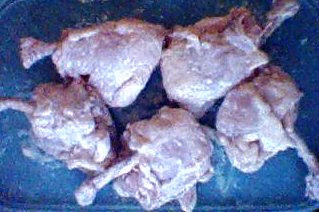Use the funnel or bottle method (softdrink bottle), if the cake has risen higher than the feet of the pan, to avoid mashing the cake down. Cooling of chiffon cakes upside doen over a funnel or bottle, is to keep the cake light and light.
Tips on making Chiffon Cakes:
* Have eggs at room temperature, to get the maximum volume when you beat them.
* Beat egg whites in a dry mixing bowl.
* Once the cake is done, remove the pan immediately from the oven and invert it to cool the cake.
* When completely cool, loosen cake around the edges and the tube sides. Use a serrated knife to slice the cake.
* Place circles of waxed paper on the bottom of the pan, but don't grease the sides. The cake clings to them to rise.
The Origin of Chiffon Cake
In the baking world, chiffon cake once had it all.
It had history. It had glamour. It had a secret ingredient. It even had publicity agents.
General Mills introduced the chiffon cake to the world in 1948 with the headline "The first really new cake in 100 years!" It was so big, sales of cake flour went up 20 percent.
And then, like an escaped party balloon, chiffon cake drifted away. No more orange cake with glaze down the sides. No more tall cakes lording over the bake sale.
Why should we breathe life back into the chiffon cake? Well, it's quick. If you're not intimidated by separating eggs and whipping egg whites, you can put together a chiffon cake almost as fast as you can make a cake from a mix.
But maybe the real reason we should rescue the chiffon cake is just because it deserves it. Because it's light and not too sweet and it looks great on a cake stand.
INVENTED BY AN INSURANCE AGENT
Who knows who made the first chocolate cake or fruitcake? But chiffon cake is different. It was invented by an insurance agent in Los Angeles. His name, believe it or not: Harry Baker.
Baking was Baker's hobby. In 1927, he came up with an unusual cake. It was light and fluffy, more tender than angel food, more flavorful than sponge cake. It became the toast of Hollywood. Baker sold it to stars for their parties, and he made cakes for the Brown Derby restaurant.
The cake got so popular, Baker was selling as many as 40 a day. For 20 years, he wouldn't tell the secret ingredient. Finally, in 1947, he agreed to sell the recipe to General Mills, so "Betty Crocker could give the secret to the women of America."
Jean Anderson researched the story for her book, "The American Century Cookbook." General Mills tinkered with the recipe for about a year before releasing it.
"Knowing home economists," she says, "they probably made it foolproof."
When the company finally released the secret recipe in the May 1948 Better Homes and Gardens magazine, it did it with a splash. Calling it "high, light and handsome," General Mills declared the cake "light as angel food, rich as butter cake."
The secret, it turned out, was vegetable oil. Baker had replaced the usual butter with oil and skipped the step of creaming butter. Instead, you make a flavored batter, and then you fold in stiffly beaten egg whites. The egg whites puff up in the oven, making a tall, fluffy cake.
You can also make it in almost any flavor. Through the 1950s, General Mills sponsored chiffon cake contests. People came up with rainbows of flavors _ orange, lemon, walnut, marble, coconut.
HEYDAY IN 1950s, `60s
Through the 1950s and `60s, chiffon was the cake to make.
"It was terribly, terribly, terribly fashionable," Anderson says. "Everybody was doing it," particularly lemon and orange.
She thinks the idea of a secret recipe originally attracted people, "Whenever there is a secret recipe, everybody has to have it," she says, like Mamie Eisenhower's fudge or the Waldorf Astoria cake.
"But this cake was a really good cake. It was such an impressive cake. It was a showy, show-offy cake."
General Mills tinkered for a decade and came out with a chiffon cake mix in 1958. But it really wasn't necessary. Chiffon cake's beauty was its simplicity.
It's easy to put together, Anderson says, and it doesn't even need frosting.
"I frankly think chiffon cake doesn't need a thing. I like it straight up. Maybe with a scoop of ice cream on top."
TWO TRICKS TO MAKING IT RIGHT
There are only two tricks to making chiffon cake. The first is beating egg whites. If the egg whites aren't stiff enough, the cake will be tough.
The other trick is using cake flour, which is lighter. The original General Mills recipe was developed using Softasilk, although any cake flour, such as Swansdown, will work.
Although the cake is best known as a tube cake, made in an angel food pan, it can also be baked as a layer cake. Just line the bottom of the pan with waxed paper and cool the cake in the pan upside down.
The pan is ungreased, so the cake can cling to the sides while it bakes. And the pan is always cooled upside down, so the cake doesn't flatten. Stand the tube pan over a funnel or a small-necked bottle until it's completely cool.
Chiffon Pans









































